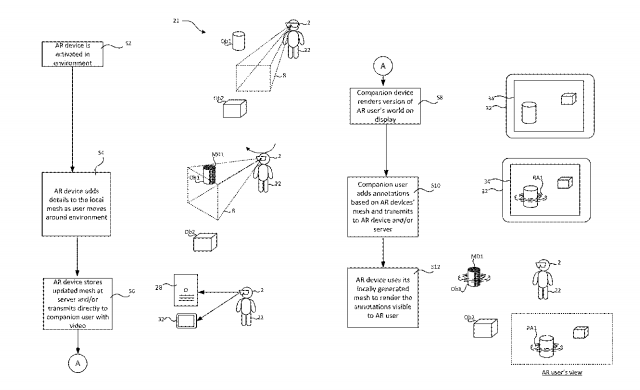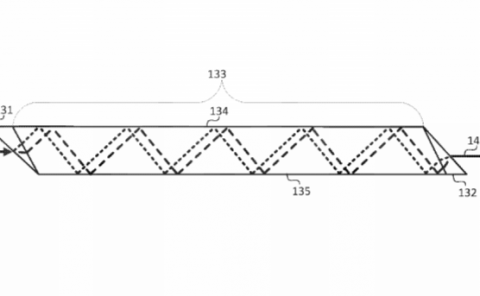Microsoft Patent | Augmented reality
Patent: Augmented reality
Publication Number: 10169917
Publication Date: 2019-01-01
Applicants: Microsoft

Abstract
An augmented reality (AR) system receives a plurality of local 3D models of a part of a real-world environment, each having been generated by a different AR device when located in the real-world environment. The local 3D models are combined to generate a global 3D model, at least part of which is transmitted to a device remote from the real-world environment. The global 3D model represents a greater portion of the real-environment than any of the local 3D models individually. The AR system receives rendering data from the remote device, and transmits it to an AR device when the AR device is located in the real-world environment. Alternatively, the rendering data may be transmitted from the remote device to the AR device via a network directly. The rendering data is for use in rendering a virtual object at the AR device in the real-world environment.
Background
Display systems can used to make a desired image visible to a user. Wearable display systems can be embodied in a wearable headset which is arranged to display an image within a short distance from a human eye. Such wearable headsets are sometimes referred to as head mounted displays. Optical components are arranged in a wearable headpiece so as to display the desired image within a few centimeters of the user’s eyes.
Some types of display systems provide a view through this optics so that the generated image which is displayed to the user is overlaid onto a real world view. This is referred to as augmented reality (“AR”), or equivalently mixed reality. An example is the Microsoft HoloLens device.
As well as a wearable display system, an augmented reality device may incorporate other components, such as processing unit(s), computer interface(s) that provide network connectivity, and camera(s) etc. These may be housed in the headpiece, as in the HoloLens, or in a separate housing connected to the headpiece by wireless or wired means.
Summary
This Summary is provided to introduce a selection of concepts in a simplified form that are further described below in the Detailed Description. This Summary is not intended to identify key features or essential features of the claimed subject matter, nor is it intended to be used to limit the scope of the claimed subject matter.
In one aspect, an augmented reality system comprises a computer interface, a global model generation module, and an augmentation sharing module.
The computer interface is configured to receive a plurality of local 3D models of a part of a real-world environment, each having been generated by a different augmented reality device when located in the real-world environment. The global model generation module is configured to combine the local 3D models to generate a global 3D model, and to transmit at least part of the global 3D model to a device remote from the real-world environment. The global 3D model represents a greater portion of the real-environment than any of the local 3D models individually. This allows the remote device to explore and augment a virtual version of the real-world environment remotely. The augmentation sharing module is configured to receive rendering data from the remote device, and to transmit the rendering data to an augmented reality device when the augmented reality device is located in the real-world environment. The rendering data is for use in rendering a virtual object at the augmented reality device in the real-world environment.
In another aspect, the rendering data may be transmitted from the remote device to the augmented reality device via a network directly (i.e. not via the augmented reality system).



